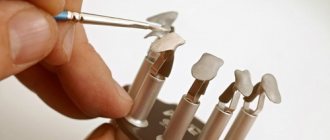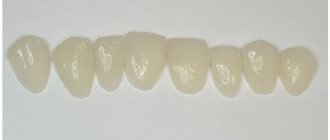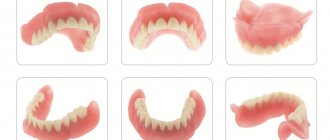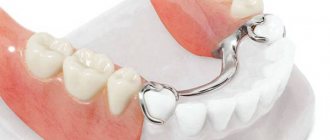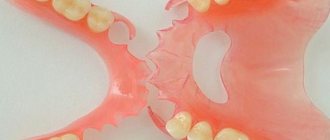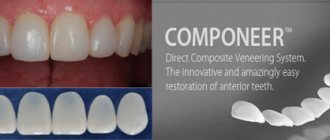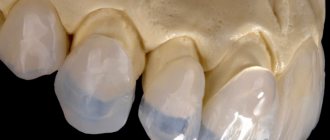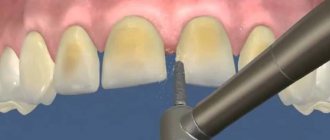Not everyone has naturally beautiful and straight teeth. In addition, after taking certain medications, suffering from illnesses or due to injuries, they can darken, wear off, and crack. Aesthetic restoration will return the dentition to its former appearance. By installing ceramic veneers, you can straighten your teeth, give them the correct shape, and eliminate cracks and chips.
| Ceramic veneers: prices | |
| Veneers category C (1 tooth) | RUB 25,700 |
| Veneers category B (1 tooth) | RUB 26,700 |
| Veneers category A (1 tooth) | RUB 27,700 |
In what cases will the dentist recommend using ceramic veneers:
- with abrasion or erosion of enamel;
- with cracks or small chips in the front teeth;
- if the dentition is uneven, there are large gaps;
- when there are darkening or stains on the enamel that cannot be removed by bleaching;
- with painful sensitivity to hot or cold drinks;
- when the patient wants to have a perfectly straight row of teeth, and this cannot be achieved in other ways.
This technology is used to correct cosmetic defects, as well as according to the indications of the attending physician. Severe abrasion of enamel, wedge-shaped gaps, and positional imbalances can cause malocclusion, causing the remaining teeth to begin to decay. Other possible consequences of such disorders include injuries to the mucous membrane, permanent chipping, and private inflammatory processes.
Presentation on the topic: "Ceramic veneers. Work done by E.N. Moskina 265 group." — Transcript:
1 Ceramic veneers Work performed by E.N. Moskina 265 group
2 Contents: 1.Veneers. 2.Indications for use. 3. Contraindications. 4. Advantages of veneers. 5. Making veneers. 6. Preparation for veneers. 7.Installation.
3 VENEERS. Veneers are ceramic (porcelain) or composite plates that replace the outer layer of the tooth. This is a dental term, synonymous with the word “facing” in Russian. They allow you to correct irregularities in the shape and color of the tooth. As a result, the restored tooth gains strength and does not differ from its “neighbors.”
4 They allow you to correct irregularities in the shape and color of the tooth. As a result, the restored tooth gains strength and does not differ from its “neighbors.” The production of veneers is primarily recommended in cases where there are the following defects in the surface and color of the teeth: Chipped teeth Gaps between teeth
5 Tooth color defects associated with fluorosis “tetracycline teeth” Enamel demineralization Tooth color defects associated with fluorosis “tetracycline teeth” Enamel demineralization, violation of the shape of teeth Wedge-shaped defects with extensive damage to hard tissues Old fillings that differ in color from the tooth Consequences of injuries or treatment root canal
Veneers at the Astra Dental dental clinic
6 The main contraindications for making veneers are: - Unhealthy teeth - Weak teeth - Teeth with insufficient amount of enamel - Bruxism (the habit of clenching or grinding teeth strongly) - Teeth that have not fully erupted - Straight bite - Teeth affected by caries. In such cases, the teeth should be treated or a crown installed (if the damage is severe). -Periodontal diseases.
7 Advantages of veneers: · speed of production; in the case of composite veneers, one visit is enough; · small grinding of hard tooth tissues; · durability, especially in the manufacture of porcelain (ceramic) veneers; · excellent aesthetics due to the absence of metal and other foreign materials.
8 Manufacturing of veneers The process of manufacturing veneers from all-ceramic mass takes place in a dental laboratory after preliminary taking of impressions from the required fragment of the jaws and subsequent fitting of the structure in the oral cavity and fixation. Stages of manufacturing porcelain veneers: 1. Clinical stage of work: preparation of a specific tooth for the design. As a result of preparation, approximately 0.5-0.7 mm of the tooth enamel layer is ground off. This is the approximate thickness of the future ceramic veneer. After this, casts (impressions) are taken from the jaws to determine the relationship between the jaws and the color of the teeth or the required color.
9 2. Laboratory stage: the taken impressions with a description are sent to the laboratory. The models are filled with plaster, followed by modeling of specific tooth miters. Modeling veneers with special materials. Sintering of ceramic mass into the shape required to restore specific teeth. 3. Clinical stage: fitting of ceramic veneers obtained from the laboratory. Processing of veneers based on their clinical situation. 4. Laboratory stage: refinement and additional grinding with polishing of the resulting veneers. Supplementing veneers with mass if necessary. Additional firing of the mass in special equipment. 5. Clinical stage: fitting of the obtained veneers. Grinding of veneers as necessary. Fixation of veneers to specific teeth.
10 Tooth preparation for a porcelain veneer: 1. In order for the porcelain veneer to be strong enough, it has a certain thickness. Therefore, a layer of enamel corresponding to the thickness of the future veneer is removed. 2. The minimum thickness of the veneer is approximately 0.5-0.7 mm, which avoids removing too much enamel and provides good strength and stability to the veneer. 3. Taking an impression. After removing a layer of enamel corresponding to the thickness of the future veneer, the dentist begins to take an impression of the patient’s teeth. Impressions are made using special impression materials, most often paste. The paste is inserted into a special spoon and placed on the teeth for a few minutes to harden it.
11 4. After hardening: the impression paste with a spoon is removed from the teeth. The resulting impressions are then sent to a dental laboratory. A dental technician in the laboratory casts a plaster model using the impressions obtained. A plaster model is an exact copy of the patient’s teeth. 5. The dental technician makes the veneer so that it fits the plaster model exactly. 6. Choosing the color of the porcelain veneer The dentist selects a shade of the porcelain veneer that is similar to the shade of the adjacent teeth. For this purpose, a set of small porcelain plates in the shape of a tooth is usually used, each plate has a different color. This set is called a color chart. From this set, the dentist selects samples of various colors and applies them to the place where the veneer will be placed.
12 7. Installing a porcelain veneer Before installing a porcelain veneer in place, the dentist evaluates how tightly it fits to the tooth, checks the shape and color of the veneer. To do this, the dentist applies the veneer to the tooth, notes the imperfections, removes the veneer, adjusts it and eliminates the imperfections, then applies it to the tooth again - and so on until the veneer accurately covers the tooth. The bite must be checked to see how well the veneer is in contact with the rest of the teeth in the mouth. After the dentist is satisfied that the veneer fits tightly around the tooth, has the correct shape, and matches the color of the adjacent teeth, he begins cementing the veneer. To do this, you first need to clean the veneer and tooth. After this, the tooth enamel is etched with a special gel. Etching the tooth enamel makes the surface rough, which increases the strength of the veneer’s attachment to the tooth. After etching the tooth enamel layer, cement is applied to the veneer and to the tooth. After this, the veneer is attached to the tooth. After attaching the veneer to the tooth with a special tool, the dentist removes the excess cement squeezed out from under the veneer.
Slide no. 1
Ceramic veneers Work performed by E.N. Moskina 265 group
Slide no. 2
Contents: Veneers. Indications for use. Contraindications. Advantages of veneers. Production of veneers. Preparation for veneers. Installation.
Slide no. 3
VENEERS. Veneers are ceramic (porcelain) or composite plates that replace the outer layer of the tooth. This is a dental term, synonymous in Russian with the word “veneering”. They allow you to correct irregularities in the shape and color of the tooth. As a result, the restored tooth gains strength and does not differ from its “neighbors.”
Slide no. 4
They allow you to correct irregularities in the shape and color of the tooth. As a result, the restored tooth gains strength and does not differ from its “neighbors.” The production of veneers is primarily proposed in cases where there are the following defects in the surface and color of the teeth: Chipped teeth Gaps between teeth
Slide no. 5
Tooth color defects associated with fluorosis “tetracycline teeth” Enamel demineralization Tooth color defects associated with fluorosis “tetracycline teeth” Enamel demineralization Disturbance in tooth shape Wedge-shaped defects with extensive damage to hard tissues Old fillings that differ in color from the tooth Consequences of trauma or root canal treatment
Slide no. 6
The main contraindications for making veneers are: - Unhealthy teeth - Weak teeth - Teeth with insufficient amount of enamel - Bruxism (the habit of clenching or grinding teeth) - Teeth that have not fully erupted - Direct bite - Teeth affected by caries. In such cases, the teeth should be treated or a crown installed (if the damage is severe). - Periodontal diseases.
Slide no. 7
Advantages of veneers: · speed of production; in the case of composite veneers, one visit is enough; · little grinding of hard tooth tissues; · durability, especially when making porcelain (ceramic) veneers; · excellent aesthetics, due to the absence of metal and other foreign materials.
Slide no. 8
Manufacturing of veneers The process of manufacturing veneers from all-ceramic mass takes place in a dental laboratory after preliminary taking of impressions from the required fragment of the jaws and subsequent fitting of the structure in the oral cavity and fixation. Stages of manufacturing porcelain veneers: 1. Clinical stage of work: preparation of a specific tooth for the design. As a result of preparation, approximately 0.5-0.7 mm of the tooth enamel layer is ground off. This is the approximate thickness of the future ceramic veneer. After this, casts (impressions) are taken from the jaws to determine the relationship between the jaws and the color of the teeth or the required color.
Slide no. 9
2. Laboratory stage: the taken impressions with a description are sent to the laboratory. The models are filled with plaster, followed by modeling of specific tooth miters. Modeling veneers with special materials. Sintering of ceramic mass into the shape required to restore specific teeth. 3. Clinical stage: fitting of ceramic veneers obtained from the laboratory. Processing of veneers based on their clinical situation. 4. Laboratory stage: refinement and additional grinding with polishing of the resulting veneers. Supplementing veneers with mass if necessary. Additional firing of the mass in special equipment. 5. Clinical stage: fitting of the obtained veneers. Grinding of veneers as necessary. Fixation of veneers to specific teeth.
Slide no. 10
Tooth preparation for a porcelain veneer: 1. In order for a porcelain veneer to be strong enough, it has a certain thickness. Therefore, a layer of enamel corresponding to the thickness of the future veneer is removed.2. The minimum thickness of the veneer is approximately 0.5-0.7 mm, which avoids removing too much enamel and provides good strength and stability to the veneer.3. Taking an impression. After removing a layer of enamel corresponding to the thickness of the future veneer, the dentist begins to take an impression of the patient’s teeth. Impressions are made using special impression materials, most often paste. The paste is inserted into a special spoon and placed on the teeth for a few minutes to harden it.
Slide no. 11
4. After hardening: the impression paste with a spoon is removed from the teeth. The resulting impressions are then sent to a dental laboratory. A dental technician in the laboratory casts a plaster model using the impressions obtained. A plaster model is an exact copy of the patient’s teeth.5. The dental technician makes the veneer so that it fits exactly on the plaster model.6. Choosing the color of the porcelain veneer The dentist selects a shade of the porcelain veneer that is similar to the shade of the adjacent teeth. For this purpose, a set of small porcelain plates in the shape of a tooth is usually used, each plate has a different color. This set is called a color chart. From this set, the dentist selects samples of various colors and applies them to the place where the veneer will be placed.
Slide no. 12
7. Installing a porcelain veneer Before installing a porcelain veneer in place, the dentist evaluates how tightly it fits to the tooth, checks the shape and color of the veneer. To do this, the dentist applies the veneer to the tooth, notes the imperfections, removes the veneer, adjusts it and eliminates the deficiencies, then applies it to the tooth again - and so on until the veneer accurately covers the tooth. The bite must be checked - how correctly the veneer is in contact with the rest of the teeth in the mouth. After the dentist is sure that the veneer tightly covers the tooth, has the correct shape and matches the color of the adjacent teeth, he begins to cement the veneer. To do this, you first need to clean the veneer and the tooth. After this, the tooth enamel is etched with a special gel. Etching the tooth enamel makes the surface rough, which increases the strength of the veneer’s attachment to the tooth. After etching the layer of tooth enamel, cement is applied to the veneer and onto the tooth. After this, the veneer is attached to the tooth. After attaching the veneer to the tooth with a special tool, the dentist removes the excess cement squeezed out from under the veneer.
dentist-implantologist, dentist-orthopedist, dentist-therapist
Dentistry DENTAL WORLD
Veneers have become a very popular solution in aesthetic dentistry in recent years. More and more clients want to hide imperfections in their front teeth and give themselves a Hollywood smile, and improving technologies make it possible to do this for a long time and with the highest quality results.
Indications and contraindications for installation
The standard set of indications for restoring teeth with veneers are:
- Small chips and cracks on the front teeth, allowing them to be used as a support for the onlay.
- Tremas and diastemas are pronounced gaps between the incisors caused by malocclusion, the consequences of diseases and other factors.
- Darkening of the enamel caused by taking tetracycline, fluorosis and poor-quality drinking water with an excess of iron and heavy metal salts.
- Painful gray color after pulp removal.
- Crowding, either congenital or after injury, such as a dislocated jaw.
- A large number of fillings that differ in color and violate aesthetics.
- Impossibility of bleaching using any of the methods.
There are a number of contraindications:
- Bruxism - involuntary grinding of teeth makes the installation of most fixed dentures pointless.
- The absence of more than 6 teeth in a row means that onlays require a reliable foundation, and if there are no molars behind the incisors, they simply will not attach.
- The tooth is destroyed by more than 45%.
- Severe malocclusions – as with bruxism, malocclusions and misalignments will lead to rapid failure.
Types of veneers
Today, the classification of veneers divides them according to materials.
Composite veneers
They were the first to appear on the aesthetic dentistry market, and for a long time occupied a leading position, thanks to their low cost and other advantages, such as:
- Good biological compatibility.
- Relatively quick installation.
But behind the apparent simplicity and accessibility there are a number of disadvantages:
- Sensitivity to food dyes.
- Fragility.
- The thickness is about 1 mm, which creates an unnatural appearance when speaking.
- The need for strong grinding of the abutment tooth.
- Service life up to 5 years.
It is the large number of shortcomings and fragility that have become the reason that most clinics are gradually abandoning composites in favor of modern materials.
Ceramic veneers
They are also called porcelain onlays because in dentistry, ceramics and porcelain are the same thing. Microprostheses have a large number of advantages:
- Immunity to food dyes and even tobacco smoke.
- A wide selection of shades, as close as possible to the natural color of the enamel.
- High strength compared to composite.
- No heavy grinding is required - the thickness of the plates is only 0.5 mm.
- Service life from 10 years.
Ceramics have one disadvantage - they are several times more expensive than composites.
Zirconium veneers
Zirconium dioxide is considered an advanced and innovative material, despite the fact that it has been on the market for more than 20 years. Recently, in addition to dentures and crowns, they began to make onlays from it, which have the following advantages:
- Increased strength, comparable to metal-ceramic crowns.
- Thickness starts from 0.3 mm, which makes them almost invisible.
- No allergies and antibacterial coating that prevents caries.
- Possibility to choose an individual shade according to the Vita scale.
- The latest generation of zirconium is indistinguishable from natural enamel.
- Service life up to 20 years
The material has two disadvantages - complex production, requiring highly qualified dental technicians, and hence the high cost, comparable to prosthetics on implants.
What is a ceramic veneer?
Veneers are thin, durable, ceramic plates that replace the outer layer of a diseased tooth, thereby correcting the color and shape. In fact, it is an artificial substitute for enamel in visible areas.
Dental technicians and dentists of our Center, using modern German equipment and technologies, gentle methods for restoring the natural shade of teeth, make veneers based on individual impressions, carefully taking care of natural enamel.
This treatment method emerged as an alternative to previously used all-ceramic crowns. Today they are successfully used by many dental clinics and dental centers. Please note that the cost of a veneer for 1 tooth in Moscow at the Center for Aesthetic Dentistry is calculated individually.
How are veneers installed? What is the service life?
There are two ways:
- The direct method is suitable exclusively for composites, when the material is applied to the problem tooth directly in the doctor’s office, hardened and ground.
- Indirect method - the onlays are made in the laboratory, after which the patient is invited to the installation procedure.
The installation itself is a rather long process, contrary to popular opinions that veneers are installed in one day and for several years. Everything takes place in several stages:
- Preliminary examination to identify the problem, diagnose, and identify possible contraindications.
- Sanitation of the oral cavity - removal of plaque and tartar, treatment of all inflammatory processes, if any.
- The first silicone impression of the jaw is taken.
- Anesthesia and preparation of abutment teeth with a drill.
- Taking a second impression, already from the ground teeth.
- If the direct technique is used, then on the same day the dental technician, based on two impressions, begins to layer the composite material on the prepared area. The veneer is allowed to harden completely, and the patient is released for rehabilitation.
- If the indirect method is chosen, then the impressions are sent to a dental laboratory, and a protective plastic crown is placed on each ground tooth.
- On the appointed day, the overlays are installed and fixed with special cement.
In total, the adaptation process takes up to two weeks, during which a strict diet and care regimen is prescribed so that the pad lasts as long as possible. On average, ceramic dentures last up to 10-15 years; over time, they will still have to be replaced due to the gradual destruction of the fixing cement.
How are ceramic veneers made?
The procedure is performed in several stages. First, an initial examination; depending on the clinical situation, minimally invasive grinding of the teeth is possible and an impression is taken. In order to obtain it, a special mass is applied to the teeth, a metal mold with a silicone impression composition is applied and pressed to obtain an impression. An exact copy will be made from it, a plaster model of the teeth, and then the veneers will be modeled. The next stage is trying on the veneers, coordinating the shape and color with the patient and fixing them. Depending on the clinical situation, it is possible to scan the oral cavity with an intraoral CEREC scanner, and subsequent modeling of future veneers in a computer program, while everything is shown to the patient on the computer.
Recommendations for installation
We must remember that before installation, be sure to study the indications and contraindications. Be sure to consult your dentist. You may be offered other options, including those related to age-related changes in the jaw.
Do not self-medicate, consult a doctor!
Don't wait for your condition to worsen!
Sign up
Veneer care
The linings will require special treatment, not only to increase their service life, but also to prevent elementary damage and possible complications:
- You will have to forget about solid food, nuts and seeds - they now need to be chewed with chewing teeth, the incisors will remain “for beauty”. Fibrous foods, including meat, are best eaten boiled or finely chopped.
- Smoking and excessive craving for alcohol are strictly prohibited. This is especially true for composite and ceramic dentures - they fade most quickly under the influence of nicotine and alcoholic beverages.
- Brush your teeth 1-2 times a week with any toothpaste containing active fluoride. Daily hygiene – as before, preferably using an irrigator filled with filtered or boiled water, and rinses.
- Change your lifestyle, especially for athletes involved in extreme sports and contact martial arts. The greater the risk of injury to the face, the higher the chances that the veneers will need to be replaced within a few months.
- If possible, visit the dentist’s office monthly for the first six months after installation to observe the “behavior” of the onlays.
How are veneers removed?
Currently, there are two methods of removal in dentistry:
- Sawing with a diamond bur - a special coating on the drill allows you to remove all the fixing cement within a few minutes and easily remove the onlay in literally one movement without harm to the supporting tooth.
- Laser removal is a similar procedure in which the role of a drill is played by a laser beam. Not suitable for too thick plates, because the laser will not be able to cut the desired layer without the risk of damaging the tooth. In such situations, the doctor uses a combination of a diamond bur and beam.
- Composite veneers – from 5,000 rubles per tooth.
- Ceramic veneers – from 20,000 rubles per tooth.
- Zirconium veneers – from 25,000 rubles per tooth.
Price for direct veneers
When comparing direct and indirect veneers, the former are much cheaper for two reasons:
- There is no laboratory stage in their production, i.e. no dental technician is involved in the process;
- photopolymer material is cheaper than ceramic mass;
- modeling takes one, maximum two visits (if the entire dentition is covered at once).
The price for direct veneers in Kiev starts from 1800 UAH per unit and in some clinics reaches 6 thousand UAH or more. In other cities of Ukraine, the price of direct composite veneers is slightly lower – 1200-3300 UAH.
In St. Petersburg and Moscow, composite veneers made using the direct method will cost at least 5-7 thousand rubles. for one tooth . It is worth considering that this price does not include preparatory procedures, such as cleaning.
Thus, this type of veneer is the most affordable of those that dentists can offer. And although the quality of direct overlays is not the highest, not everyone can afford to install a Hollywood veneer at a price of 40 thousand rubles. Therefore, direct dental restoration remains among the top most popular dental procedures.
Reviews
There are quite a lot of reviews about veneers, partly due to the accessibility of the procedure. Not all comments are positive, based on which it is worth making several important reservations:
- A week after installation, most patients experience increased sensitivity to cold and hot drinks. There is one way to reduce discomfort - do not indulge in tea, coffee or chilled soda until your teeth get used to the “renewal”.
- If there is slight swelling of the gums, it is better to play it safe and make yourself a weak rinse solution - chamomile, calendula or sage will do. You need to rinse your mouth for 30 seconds 2-3 times a day, preferably after meals.
- If bruxism is suspected, your dentist may prescribe night guards. It is better to use them constantly, remembering to wash them and keep them in a place protected from light.
- Grinded teeth. Unfortunately, there is no way to return it back. Once the veneers have served their purpose, you will have to install new onlays, or choose a durable zirconium dioxide crown, if finances allow.
Tooth preparation is a dental procedure that involves removing (grinding) surface dental tissues and giving the dental crown a shape that would allow it to be easily covered with a prosthesis.
Until recently, teeth grinding was considered one of the most unpleasant and painful dental procedures. In modern medical practice, dissection is performed under local anesthesia using high-tech equipment to minimize discomfort from the procedure.
Why is it necessary to prepare teeth?
Most patients are puzzled by the question: is it possible to refuse preparation and install a prosthetic device on an intact tooth?
Answer:
Unfortunately, to date, not a single prosthetic method has been developed that would allow one to avoid this unpleasant procedure. This is explained by the fact that before treatment, the supporting teeth have an irregular geometric shape (convex side walls, tubercles and grooves on the chewing surface), which does not allow for a tight fit of the prosthesis to the enamel. The presence of a gap between the tooth and the inner surface of the crown not only prevents the prosthetic device from being securely fixed, but also contributes to the occurrence of secondary caries.
During preparation, the dentist gives the supporting tooth the correct geometric shape. This makes it easy to put an orthodontic structure on it so that it does not cause discomfort to the patient and does not cause the development of secondary pathologies.
Application for bridge prosthesis
Application for dental veneers
Manufacturing and installation methods
There are two ways to make these onlays: indirect and direct (therapeutic veneers). For the first, the tooth pretreatment procedure is identical to ceramic plates. First, the top layer of enamel is ground down, then an impression is made of the teeth on which veneers need to be installed. A mold is cast based on the impression and overlays are made based on it. The dentist installs the finished plates on composite glue.
The essence of making a veneer using the direct method is to prepare it on the tooth itself at the first visit to the dentist. The material used is the same as for the indirect version. The only difference is the impact on the pad using high pressure or temperature, which is only possible in laboratory conditions. As a result, onlays made using the first method are much stronger, but restoring teeth with composite veneers made using the direct method has a significant advantage. To use them, the doctor does not have to grind down the entire front part of the tooth. Only the part that needs to be changed is prepared.
It is better to use the indirect method if the patient needs to correct several teeth at once. In this case, he will visit the doctor twice instead of once, but much less time will be spent. For minor damage and correction of one or two teeth, it would be more logical to use a direct composite veneer. Moreover, its cost is significantly lower than that of indirect.
Photo before: installing a veneer on a chipped tooth Photo after installation
Main types of tooth preparation
In modern dental practice, five main methods of tooth preparation are used:
- tunnel;
- laser;
- ultrasonic;
- chemical;
- air-abrasive.
Tunnel preparation
For tunnel turning of abutment teeth, turbine units are used, equipped with speed regulators, as well as metal or diamond tips.
Advantages of the tunnel view
The main advantage of this technique is the ability to control the thickness of the removed layer of dental tissue.
Disadvantages of the tunnel view
The disadvantages of tunnel grinding of teeth include:
- severe overheating of the enamel;
- increased risk of injury to the soft tissues of the mouth if the technique of performing the procedure is violated;
- a high probability of cracks and microscopic chips appearing on hard dental tissues when using worn out or low-quality instruments.
Laser preparation
For laser preparation, pulsed lasers are used to heat the water contained in the hard dental tissues and destroy the integrity of the enamel and dentin. Pieces of sanded fabric are cooled and removed using a special air-water mixture.
Advantages of the laser type
The advantages of laser tooth preparation include:
- high turning speed;
- safety (no equipment elements rotating at high speed);
- absence of noise from the operation of laser equipment;
- low heating temperature of the treated tissues;
- no cracks or chips on the edges of the pin.
Ultrasonic preparation
With ultrasonic preparation, the grinding of teeth is carried out due to high-frequency vibration of the dental instrument under the influence of ultrasound.
Advantages of Ultrasonic View
The main advantages of this method are:
- no negative effect of ultrasonic waves on pulp tissue;
- release of a small amount of thermal energy that is not capable of causing significant overheating of dentin and enamel;
- painlessness;
- no chips or cracks on the pin stacks.
Air abrasive preparation
When using air-abrasive tooth preparation, instead of a drill with a rotating drill, an abrasive-air mixture is used, supplied to the desired area under high pressure. When abrasive powder gets on enamel or dentin, tissue destruction occurs.
Advantages of the air-abrasive type
The advantages of this turning method are:
- absence of tissue overheating and excessive vibration;
- high speed of the procedure and its relative simplicity;
- maintaining the maximum volume of dental tissue;
- painlessness of the performed manipulations.
Chemical preparation
The chemical preparation method of teeth involves softening enamel and dentin using acids and other active chemicals.
Advantages of the chemical type
The advantages of this technique include:
- absence of microcracks and chips on the treated surface;
- painlessness;
- absence of thermal damage to dental tissues.
Disadvantages of the chemical type
The only disadvantage of chemical preparation is the long duration of the procedure.
How is tooth preparation done?
The choice of preparation method directly depends on:
- clinical situation,
- technical equipment of the dental clinic,
- client's wishes.
Grinding of pulpless teeth is carried out without anesthesia (except for those cases when the doctor has to use special threads to move the gums back). If the procedure is performed on living (vital) teeth, the patient may require local anesthesia.
Grinded teeth are necessarily protected with temporary crowns. This allows you to keep damaged dental tissues in an acceptable condition until they are covered with a permanent prosthesis.
Teeth preparation should be carried out only in specialized medical institutions that have positively proven themselves in the dental services market. Only a professional and competent approach to the procedure allows not only to achieve the desired result, but also to avoid the development of complications.
A tooth on which the neurovascular bundle (pulp) has been removed is called a pulpless or “dead” tooth. The canal through which the nerve was removed is sealed with a reliable filling material - glass ionomer cement. This manipulation protects the tooth from penetration of microbes and periodontitis pathogens into the drilled hole. But this does not prevent the pulpless tooth from darkening after some time.
Is it possible to put veneers on pulpless teeth?
After some time, the filled tooth begins to change. The filling itself and the tooth become yellow or dark in color. This negatively affects the aesthetics of both the tooth and the entire frontal row in general. This is when a person goes to the dentist to get veneers.
Previously, veneer installation on a pulpless front tooth was not carried out. The absence of a nerve was considered an absolute refusal to place a cosmetic microprosthesis. Today, innovative technologies make it possible to veneer the front teeth on a “dead” tooth. But only strictly on an individual basis.
A little bit of my advertising: I, Sergey Samsakov, a leading orthopedist at the largest dentistry in Moscow - the CERECON clinic, will examine the problem area of the dentition, and if the condition of the tooth without the nerve and adjacent teeth is satisfactory, then I can recommend putting veneers on the front teeth.
In the absence of a nerve in the tooth, the following will be determined:
- Method of installing veneers on upper teeth.
- Principle of treatment.
- Number of teeth to be restored.
- Type of material for making veneers.
- How much will veneers cost?
Work examples:
In what cases is it recommended to install ceramic veneers?
Below are the main recommendations from our dentists.
The success of installing veneers largely depends on proper fixation and the use of quality materials.
Indications for installation of veneers:
If you have cracks or stains on your teeth, worn or discolored enamel, uneven front teeth that are sensitive to irritants, fluorosis or enamel erosion, then veneers are the best solution to your problems.
You can safely contact the SmileStudio clinic, where our highly qualified dentists will examine, identify all problems and make your dreams of a beautiful smile come true quickly and painlessly!
Contraindications for installing veneers:
If you have an incorrect bite, removed nerves on the front teeth, dead or damaged teeth, periodontitis, periodontal disease or ginginitis, then you should temporarily leave the question of installing veneers, undergo an examination in a clinic and hear the opinion of a specialist.
There are many contraindications that can be resolved and proceed to the installation of veneers. Therefore, do not be upset if you have the above problems. Contact the SmileStudio clinic, where, first of all, you will become the owner of healthy teeth and a beautiful smile.
Do you want to put veneers on pulpless teeth and change your life?
Sign up for a consultation on veneers with Sergei Samsakov!
Diagnostics before installation is required
Veneers are an important practical aspect of the science called aesthetic dentistry. Before placing veneers on pulpless teeth, a complete diagnosis of the dental system is carried out. As a rule, having decided to veneer a dead tooth, I replace the old filling and re-clean the inside of the canal. I prescribe additional treatment. The final result and how long the veneers are placed depend on the patient’s conscientious compliance with all the instructions of the attending physician.
Advantages and disadvantages
Veneers can be used to correct many different defects. You can make your teeth perfect, change an unattractive shape, eliminate wide gaps, and restore enamel that is not amenable to chemical whitening. At the same time, veneers will not make teeth stronger, but will only change their appearance. If not properly cared for, veneers can peel off, crack, and break. The cost of the veneers procedure is much higher than the whitening procedure.
If you already know what you want and have decided to install veneers, then give preference to trusted dental centers. One of them is the German Center for Aesthetic Dentistry SDent. This is the only way you can get a perfect snow-white Hollywood smile in the shortest possible time.
Startsmile experts - leading dentists in Moscow
The doctors at our aesthetic dentistry center SDent are among the leading specialists in the field of dentistry throughout Moscow.
More details
We will install high-quality ceramic veneers on the lower, upper or both jaws. We will not only install high-quality veneers, but also tell you how to properly care for them.
What to choose: veneers or crowns for the front teeth
A tooth with a removed neurovascular bundle ceases to receive “nutrition”, bone tissue loses strength and becomes fragile. Practical experience shows that it is better to install a crown on such teeth; its aesthetic properties are not inferior to a veneer attachment. I will help you make the right decision in each specific case.
What is the difference between a veneer and a crown?
Crowns and veneers are artificial attachments to teeth (prostheses). Used for restoration of the dentofacial apparatus. With their help, the appearance of dental units changes. Partial destruction, gaps between teeth, darkening and other cosmetic defects are hidden.
The same materials are used for their manufacture: ceramics, porcelain and composite, but metal is added to create crowns.
There are also fundamental differences between crowns and veneers.
Veneers are very thin plates and cover only the visible part of the tooth, the inner side remains open. Those. half a cap. Such onlays perform a purely aesthetic function and veneers are installed on one or two or all front teeth. A crown is actually a full-fledged sealed cap that protects the tooth from all sides.
It is not recommended to place cosmetic attachments on teeth involved in the chewing process, as they will not withstand heavy loads and will quickly fall off, and considering how much ceramic veneers cost, this does not make sense.
How to make veneers on front teeth
The procedure for installing overlays is divided into two phases. First, after examining the oral cavity, I conduct a full examination and choose the type and color of the mini-prosthesis. Then I prescribe treatment for the identified pathologies. The teeth on which veneers are supposed to be placed are ground down and impressions are made. As soon as the dentures are ready, the second final phase begins - the manufactured veneers are glued to the front of the teeth.
What is a tooth crown?
A crown is a non-removable prosthetic structure that completely covers the problem tooth:
Indications for placing a crown:
- carious tooth destruction of more than 60% with preliminary reconstruction of the stump;
- significant defects in tooth enamel, chips;
- excessively rapid grinding of teeth;
- pathological lesions of teeth of a non-carious nature;
- hypersensitivity.
The high strength of crowns allows not only to prevent further tooth decay and restore aesthetic appeal, but also to maintain the functionality of chewing units.
It is impossible to secure a crown without a reliable foundation, and if the tooth is completely destroyed, one of the ways to restore the coronal part of the tooth is performed: placing a stump tab or a pin. The lower part of the strong rod is inserted into the root canal, and the other is located above the gum and serves as a support for the crown.
The main difference between crowns and veneers is the degree of tooth coverage. When installing a crown, the entire tooth is ground down, and partial preparation is done for the veneer. Since only the visible part of the tooth is masked.
THERE ARE CONTRAINDICATIONS. SPECIALIST CONSULTATION IS REQUIRED.
Benefits of veneers
This dental microprosthesis, a non-removable onlay for a tooth, completely repeats its correct anatomical shape and imitates enamel. This is a simpler and less traumatic procedure than installing crowns. Veneers completely replicate the anatomy of the tooth, so there is no discomfort during eating. They look natural, mask irregularly shaped teeth, even out the bite and provide a snow-white smile.
With the help of veneers, you can get rid of any tooth enamel defects (congenital, acquired), including:
- get rid of fluorosis spots;
- lighten teeth darkened after injury;
- change the color of tetracycline teeth;
- fix chips;
- reconstruct the tooth, adjust its shape;
- hide gaps and improve appearance.

